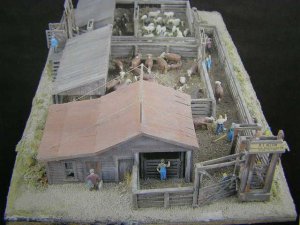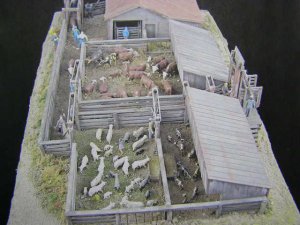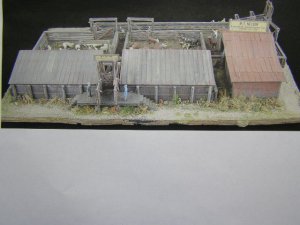Another thing to consider if you are modeling in the1950's or earlier when live stock were still routinely shipped by rail is that the railroad was required to stop the train every few hours and water the animals. They may have had to feed them as well. I think that the most common practice was to have stock pens on a siding adjacent to the mainline where the livestock would be turned out to eat and drink before being loaded back onto the train. I think such trains would usually have a drover's caboose, or an old coach on the back to house the cowboys who rode the train to herd the animals. The railroad was required to allow the animals time to eat and drink enroute, but to my knowledge, the shipper was required to supply the stock handlers to herd the animals off and on the train. Such a facility would consist of multiple chutes and small pens only with a watering trough on one side. Basically the pen would be big enough to hold one carload of animals. The railroad would want to stop the train in one place, unload all of the animals, allow them to drink, and herd them back on the train. The pen might be big enough to hold a number of carloads with multiple chutes, but I think the railroad would want to limit forward and backing moves as much as possible to make the stops no longer than necessary. There would be no need for buildings on the site. Another possibility is a pen and loading chute set upon a ranch that would be set on a siding next to the mainline but away from the ranch headquarters. Such loading pens allow for a loading facility in a very limited space.
For you guys modeling the U.P. in Southern California, the Farmer John packing house in Vernon (industrial suburb of Los Angeles) used to receive pigs on the U.P. hogex. They were still receiving them in the 1990's, I don't know if the practice continues. I saw the hogex go by our shop in the City of Industry once then after it passed I smelled it!! The train consisted of 3 large diesels, and about 4-5 stock cars. It was traveling about as fast as any train I ever saw go by. I think the hogs were probably loaded in the midwest, and delivered to So Cal. I'm sure they were kept on the fatest schedule the U.P. could run in order to minimize the number of watering stops required for the hogs. I'm not sure if the train needed all of the power units they had on the point, or if there was an extra unit to give the crew more room between them and the smell!


 I seem to have somehow missed your initial arrival.
I seem to have somehow missed your initial arrival. 

